Deploying ScaleGrid vApp on your vCenter
This document covers how to deploy ScaleGrid Enterprise on your on-premises VMware® infrastructure. If you are looking to deploy on the cloud, or need a multi-node highly available setup, please refer to our ScaleGrid Enterprise Quick Start Guide instead.
Pre-requisites
You will need VMware vCenter® 6.7 or later to deploy the ScaleGrid Enterprise VMware vSphere® vApp™ on your setup. Please ensure the following requirements can be met before attempting to deploy the OVA.
Compute
- RAM: 8 GB
- CPU: 2 vCPU
Storage
- 120 GB free space on a datastore of your choice
- An NFS share, to be mounted on the deployed VM, for nightly backup of ScaleGrid Enterprise Server’s database. At least 70GB free space must be available on this backup server.
Network & Firewall
It is important to secure the ScaleGrid Enterprise node(s). We recommend you lock down access using firewall rules, and any other network security features you use.
The ScaleGrid server requires ports used by the following services to be opened/enabled:
| Port | Notes |
|---|---|
| TCP 443 | Used for HTTPS access to the web UI. Needs to be open to all clients that wish to access the ScaleGrid UI. |
| TCP 80 TCP 443 TCP 5671 | All deployed database servers need to be able to reach back to the ScaleGrid Enterprise Server on these ports. WARNING: If you plan to deploy database servers on a different network, please ensure appropriate routing. |
Miscellaneous
ScaleGrid Enterprise Server also requires a SMTP setup. You will be prompted for connection details when you set up the vApp.
It is used to send emails to alert for certain events - for example, when a database server exceeds 80% disk utilization, the owner is alerted via email (in addition to any other method they have set up).
Recommendations
- We recommend you provision the single node ScaleGrid Enterprise Server vApp on an HA-Enabled Cluster. Please refer to VMware’s documentation if you need help setting this up.
- Provision storage for ScaleGrid VMs on SSD disks for best performance
Deploying the vApp
Contact ScaleGrid Support team at [email protected] to obtain the latest ScaleGrid Enterprise OVA. If your vCenter does not have internet access, or is affected by KB 79986, please download the OVA to your computer before you proceed.
- Log in to your vCenter and right click on the resource-pool, or cluster, where you wish to deploy the ScaleGrid Enterprise Server. Select Deploy OVF Template. This will open the deployment wizard
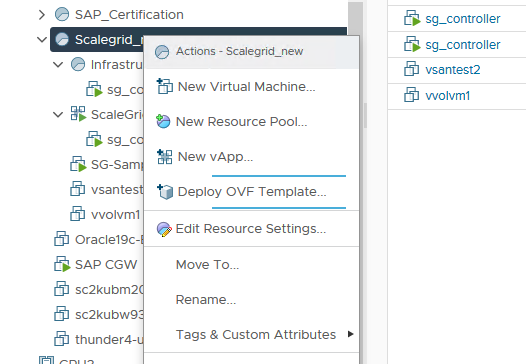
Deploy OVF Template
- Specify the ScaleGrid Enterprise template. If your vCenter has access to the public internet, you can specify the URL - or you can upload from your local computer
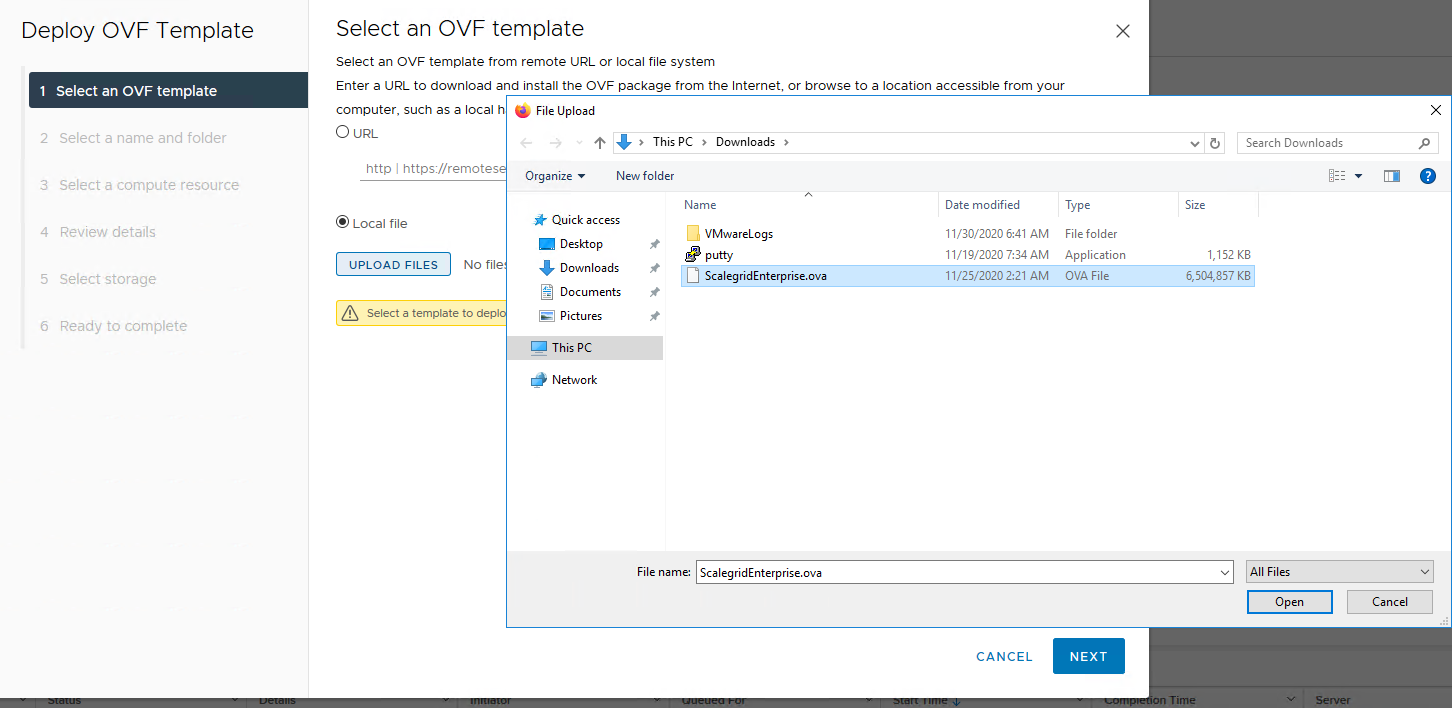
Select an OVF template
- Select a name for the vApp and the folder to deploy it in. We would recommend creating a folder to hold the ScaleGrid VMs for easier organization
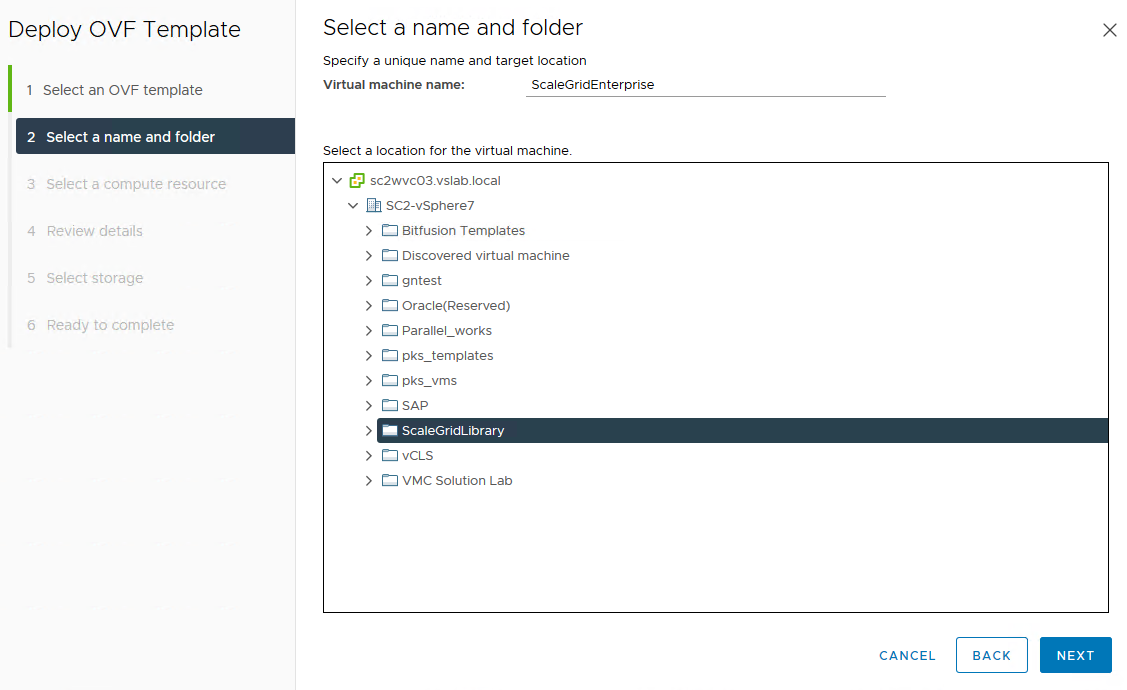
Select vApp name and folder
- Verify that the compute resources are correct
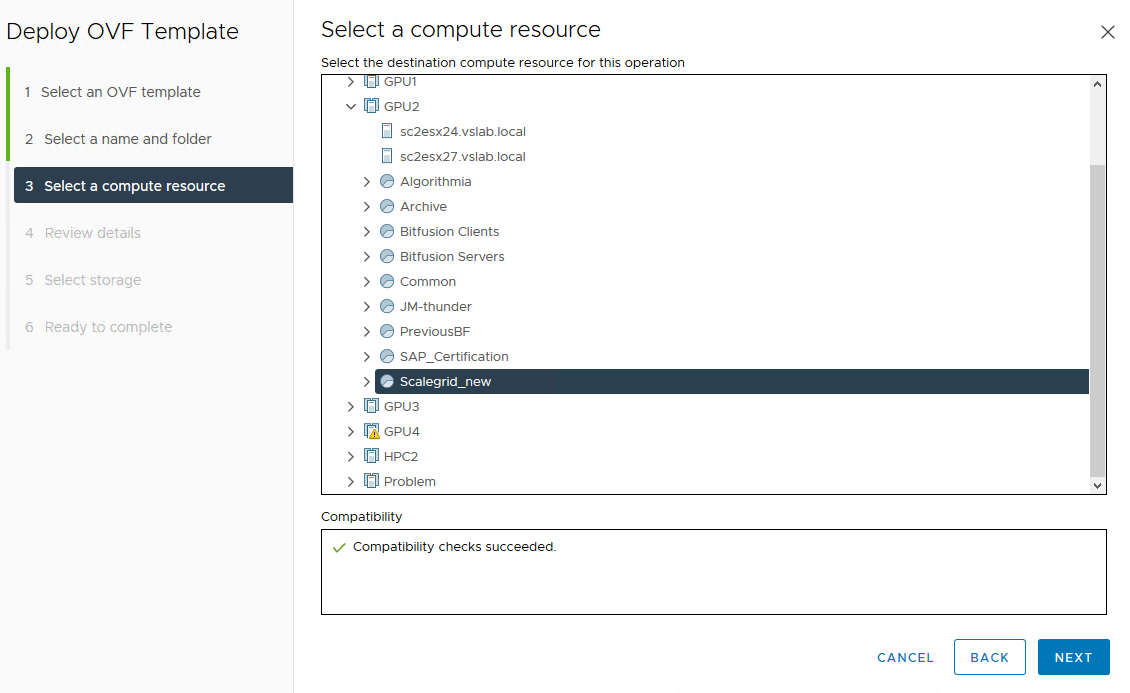
Select a compute resource
- Review the details and make sure they match

Review details
- Accept the license agreement. You can also review this document on our website

Accept license agreements
- Select a datastore to deploy on. We recommend using one backed by SSD disks. If you are thin provisioning, we recommend ensuring there is at least 30GB of free space for ScaleGrid Enterprise Server to use

Select storage
- Select the network details
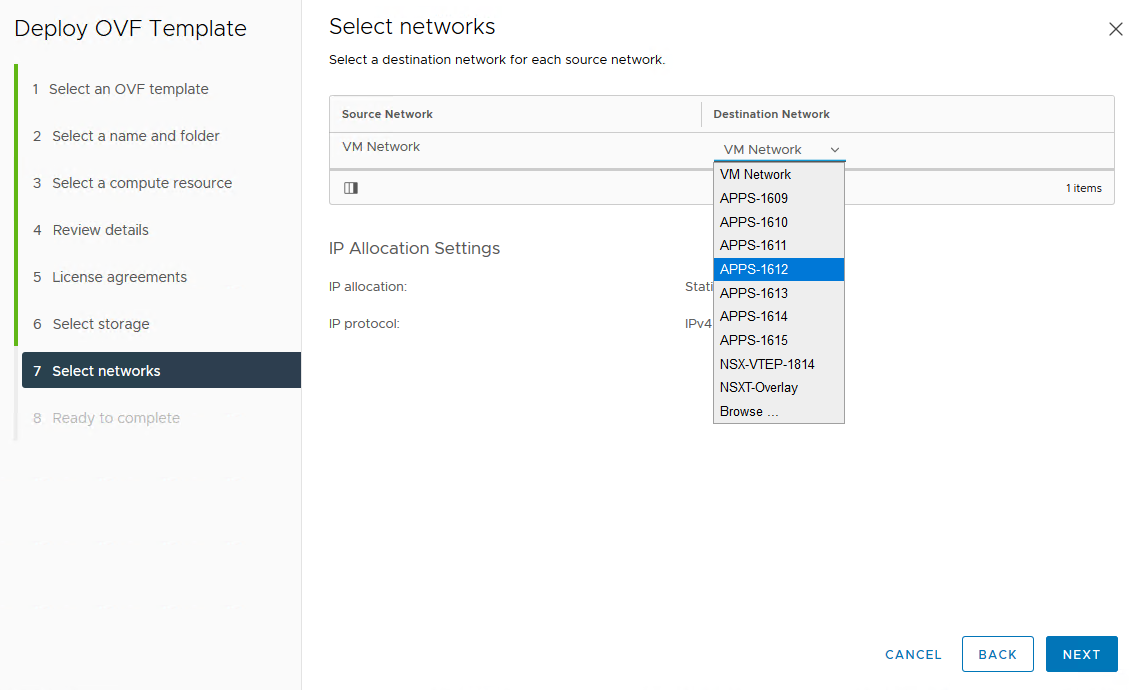
Select networks
- Click Finish to start the deployment. A new vApp (ScaleGridEnterprise) will be deployed
- Once the task completes, power on the vApp and move on to the next section
Prepare the deployed VM
Now that the VM has been powered on, it is time to validate connectivity and mount the NFS folder for backups.
Find the preconfigured credentials for the VM by navigating to Configure → Settings → vApp properties in the vApp.
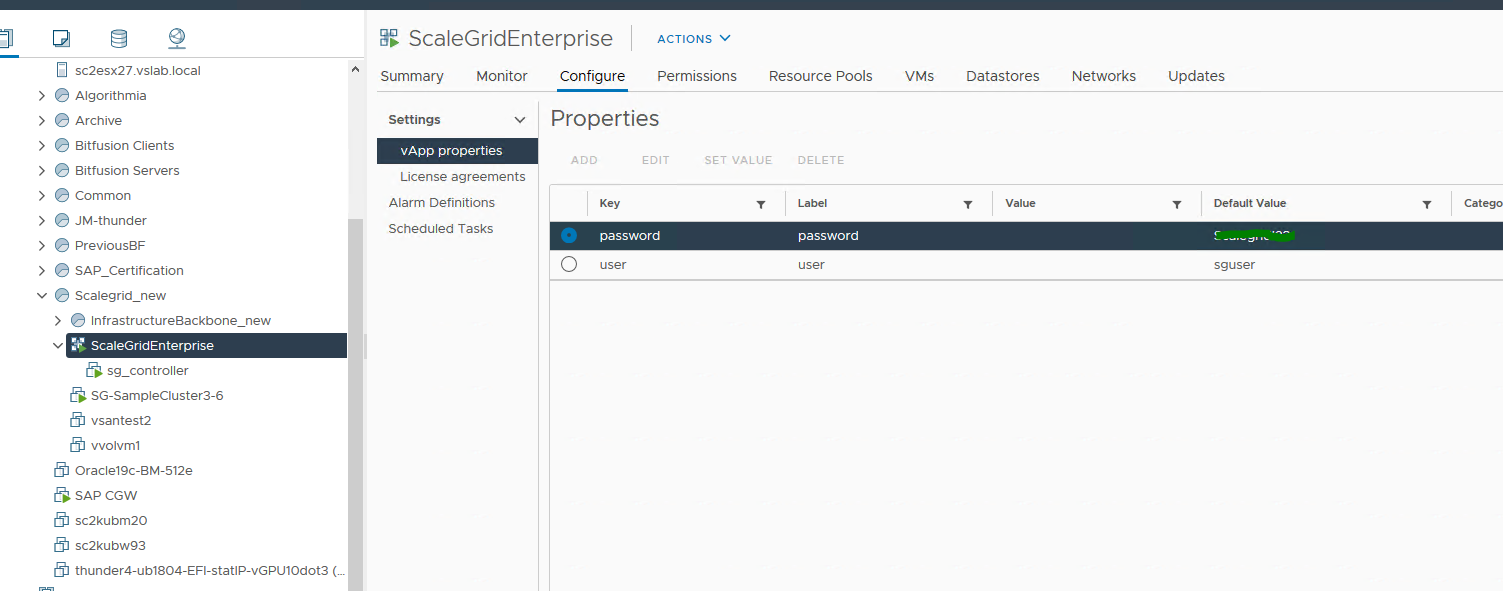
vApp properties
Log in through the VMware vSphere® Console using the creds (or if your network has a DHCP server, you can use the assigned IP address to SSH in)
Set your password!
You will be prompted to change the password on first log-on. Make sure to save the new password - there is no way to recover it.
The new password must fulfill the following requirements -
- At least 10 characters in length
- Differ from the previous password by at least 5 characters
- Cannot be based on a dictionary word
Once logged in;
- Setup a static IP for this machine. Alternatively you could also set up a DHCP reservation
- Mount an NFS folder where database backups can be stored to /var/backup/scalegrid. Please note this location must offer at least 70GB of free space
Using dynamic IP addresses
ScaleGrid Enterprise Server will require manual re-configuration if the IP address assigned to this node changes. You must set up a DHCP reservation, or a static IP address.
Optionally,
- If your network has a name server configured, you can setup a DNS entry for this machine, and update the hostname
- If your company policies require any additional security/monitoring/backup configuration, now is a good time to set them up. Please contact [email protected] to validate any software you plan to install, or any configuration you plan to change.
Once you are satisfied with the VM Configuration, you can move on to the next section.
Configure ScaleGrid Enterprise Server
The ScaleGrid binaries are already installed on this VM. However, you will need to provide some details before they are ready to use. You will find a script called scalegrid-setup.sh in the home directory, run it as root:
sudo ./scalegrid-setup.shYou will be required to enter the following information →
ScaleGrid Enterprise Bind Address
Is there a public IP assigned to the box? [y|n]:By default, ScaleGrid Enterprise Server will use the first IP Address listed via "hostname -I" as the primary entry point. This is typically the local address associated with eth0.
If you wish to continue with the default IP, type ‘n’ or ‘no’ here.
If you have configured more than one network interface, or a virtual/external IP, type ‘y’. You will be prompted to enter the IP you wish ScaleGrid Enterprise Server to use as the primary access point.
Make sure the chosen IP is routable!
The database machines will attempt to contact the messaging server at the IP you choose in this step. Make sure the IP you choose is routable from the subnet where you intend to deploy your database servers.
Please enter the public IP or press enter to use the local ip as the main access point for this box. []:This prompt is shown only if you answered ‘y’ to the previous question. You can enter the IP you want to configure as the primary access point. Please ensure the IP you enter is accessible by all your planned end users.
Make sure to use a static IP!
If this IP changes, your ScaleGrid Enterprise Server will require manual re-configuration. Please ensure this is a static IP/has an appropriate DHCP reservation. If you need to change this after installation please contact ScaleGrid support ([email protected]).
SMTP details
Please enter SMTP details so the controller can send email notifications.This set of prompts takes the inputs required to enable ScaleGrid Enterprise Server to send out emails. Emails may be sent for system warnings and failures, for alerts configured on particular metrics for further details on alerts) and also for notifications about database cluster actions.
SMTP Host :This is the hostname of the server where your email server is hosted. This must be resolve from all the ScaleGrid Enterprise Server node(s)
SMTP User :The username through which ScaleGrid Enterprise Server can authenticate with your email server. We recommend creating a separate user for ScaleGrid Enterprise Server.
SMTP Password:The password for the SMTP user. If you need to change this after installation please contact ScaleGrid support ([email protected])
Is SMTP-over-SSL enabled? [y|n]If you answer ‘y’ or ‘yes’ to this question, all communication to your email server will be encrypted. If you answer ‘n’, all communication will be over clear-text.
Notification alias
Enter an email address where alerts about important system events (e.g. unhealthy databases) can be sent. This is typically an alias, like [email protected]: Whenever a system needs to send an alert, an email will be sent to this address. This helps ScaleGrid Enterprise Server administrators take proactive action to avoid issues with your database. Please ensure this is a valid email address that is reachable from your email server.
ScaleGrid Controller backup
Enter a location on the local filesystem to store database backups or press enter to accept default location [/var/backup/scalegrid]It is important to take regular backups of your ScaleGrid Enterprise Server. For this reason, we have set up automated backups that run every night. We strongly recommend these backups be stored on a NFS share, and not on the same volume as your root file system.
You can choose to accept the default path by hitting enter, or enter the absolute path to the folder where you wish to store the backup. If the path does not exist, the installation script will create the folder hierarchy.
DNS details
ScaleGrid Enterprise Server generates self-signed certificates for *.domain. Please set up the domain name you plan to use.
DNS Suffix for the domain (e.g. .dbservers.mycompany.com):SSL certificates generated for your database server will use "*.<dns-suffix-you-enter-here>" as server names.
If you have DNS set up in this network, you should enter your domain suffix here. If you do not plan to use DNS with this set up, you can enter any name you want to use for the SSL certificates.
Supported Platforms
What cloud platforms do you wish to enable?
Valid values (OpenStack | VMWare | Linode | OCI | GCP | AWS | Azure | DigitalOcean)
Please enter a comma separated list to enable multiple, or enter to accept default [VMWare] :
ScaleGrid supports multiple public clouds, in addition to VMware vCenter - as well as private clouds compatible with OpenStack. By default the vApp only enables hosting database machines on VMware vCenter, however you can choose to enable other platforms here.
Note: If you wish to deploy databases on to public clouds, please contact product support first to ensure all per-requirements are met.
And that's it. Please wait for the configuration to complete and display the log-in credentials to your ScaleGrid Enterprise controller
Save your password!
There is no way to recover or reset this password. Please make sure to save it before proceeding further.
Accessing your ScaleGrid Enterprise Server
Secure administrator account
Point your web browser to https://<your-bind-address> and log-in with the username and password that was shown at the end of installation. This user is the root user and is used only for administrative purposes (support, gathering logs, upload logs etc). This user cannot deploy any clusters.
Once you have logged in, please change your password and enable Two-Factor Authentication (this is required to be able to use the support console). To enable 2FA, navigate to the Settings -> Users -> Two Factor Auth tab to enable two factor authentication for your setup. This is required to access the support console with ScaleGrid (filing tickets, upload logs etc).
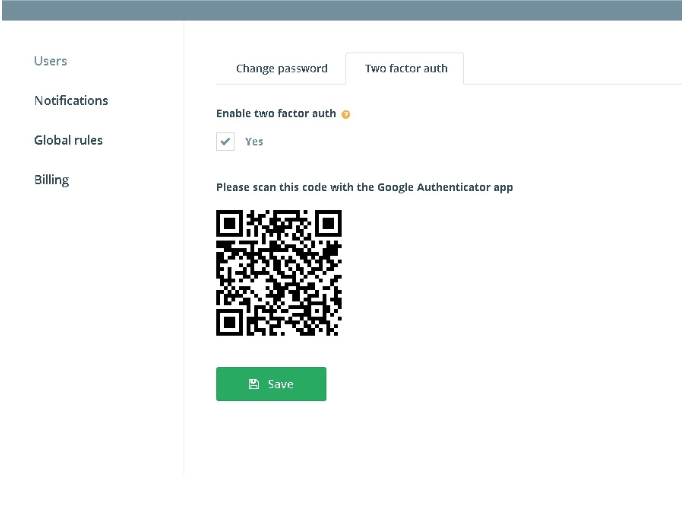
Enabling 2 Factor Authentication.
Create end user account
Logout from your root account and point your browser to https://<scalegrid-server-ip>/users/register. This will present a dialog box to create a user with username and password. Once signed up, you can use this user to create database clusters.
Each account is an isolated tenancy and the users of one account has no visibility into the clusters in another account. Once you have created an account, the account owner can invite other team members to their tenancy.
You can create as many accounts as you need to segment the administration of your clusters. E.g. You can create one account to administer your MongoDB server and another account for your Redis™* servers.
Connect your vCenter
Prepare and setup your VMWare vCenter for ScaleGrid integration.
Create a new cloud profile to connect your vCenter setup to ScaleGrid.
We recommend creating a dedicated vCenter user for each account. Please refer to this document for details of what permissions are required.
Create a database cluster
Create a new database cluster or import an existing database server/cluster into ScaleGrid Enterprise Server.
Take a look at Create a MongoDB Cluster | Create a Redis™ Cluster | Create a MySQL Deployment| Create a PostgreSQL Deployment
Support
In case you run in to any issues, please contact ScaleGrid Support with the relevant logs. Please review the Support document for more details.
* Redis is a trademark of Redis Labs Ltd. Any rights therein are reserved to Redis Labs Ltd. Any use by ScaleGrid is for referential purposes only and does not indicate any sponsorship, endorsement or affiliation between Redis and ScaleGrid.
Updated over 1 year ago
